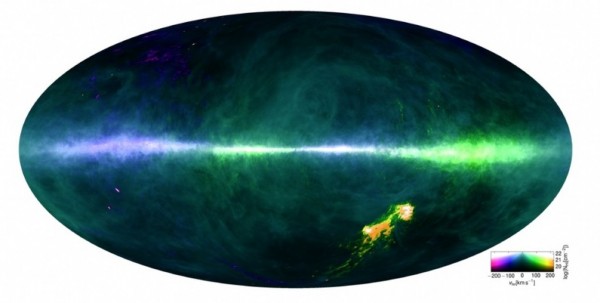By Ana Verayo, | October 22, 2016

The entire sky in the light of neutral atomic hydrogen (HI) as seen by the Parkes and Effelsberg radio telescope.
Scientists have created another detailed map of the galaxy. This time, astronomers put together a hydrogen map of the Milky Way. This new map was made using intensive data spanning 10 years, courtesy of two radio telescopes.
This is considered to be the first highly-detailed map of the entire sky. Past studies have only mapped smaller regions of the sky to see our galaxy, says astronomer Lister Staveley-Smith from the International Centre for Radio Astronomy Research in Perth, Australia.
Like Us on Facebook
Staveley-Smith describes this map as a combination of both the northern and southern hemispheres, similar to viewing two halves of the global sky as a whole for the first time.
The team utilized two radio telescopes for the study - the CSIRO Parkes Radio Telescope in New South Wales, Australia, and the Radio Telescope Effelsberg at the Max Planck Institute for Radio Astronomy in Germany.
This new map was created to study the neutral hydrogen in the galaxy, which is also the most abundant element in the universe. Staveley-Smith adds that this a unique hydrogen map of the sky that regular, optical telescopes cannot see.
Data for this map was obtained from a survey known as HI4PI, which revealed the most intricate features of our Milky Way, including cosmic shells of stellar dust and gas made from massive supernovae explosions.
The team also said that this map shows how this interstellar gas and dust are the material that stars are born from. By studying the amount of gas inside the Milky Way, astronomers can better understand how our galaxy evolved and even predict its future evolution.
This new study was published in the journal Astronomy and Astrophysics.
-
Use of Coronavirus Pandemic Drones Raises Privacy Concerns: Drones Spread Fear, Local Officials Say

-
Coronavirus Hampers The Delivery Of Lockheed Martin F-35 Stealth Fighters For 2020

-
Instagram Speeds Up Plans to Add Account Memorialization Feature Due to COVID-19 Deaths

-
NASA: Perseverance Plans to Bring 'Mars Rock' to Earth in 2031

-
600 Dead And 3,000 In The Hospital as Iranians Believed Drinking High-Concentrations of Alcohol Can Cure The Coronavirus

-
600 Dead And 3,000 In The Hospital as Iranians Believed Drinking High-Concentrations of Alcohol Can Cure The Coronavirus

-
COVID-19: Doctors, Nurses Use Virtual Reality to Learn New Skills in Treating Coronavirus Patients







